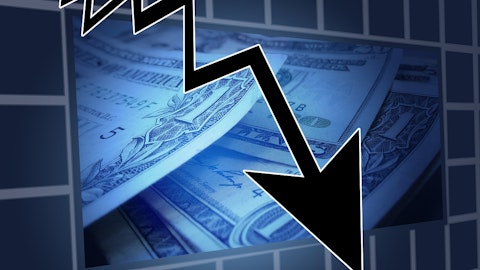In this article, we will discuss the 11 Worst Performing Stocks to Invest in on the Dip.
Goldman Sachs expects the global equities to post strong long-term returns despite higher valuations. The firm’s forecast of 7.7% per annum (in USD terms) over the upcoming decade remains close to the historical median, thanks to structural drivers such as nominal growth, profitability, and shareholder distributions.
What Should Investors Focus On?
According to Goldman Sachs, earnings growth is a primary driver of performance. The firm expects global earnings, which include buybacks, to compound at ~6% annually. Furthermore, dividends offer the rest of the return, while anticipating valuations to ease modestly from the present elevated levels.
Morningstar, while quoting Morgan Stanley’s chief US equity strategist Mike Wilson, highlighted that earnings growth and an accommodative Fed are expected to support market multiples. Wilson and team raised their 12-month target (by 2026 end) for the S&P 500 to 7,800. According to them, economic conditions in the next year are expected to benefit from growth-positive factors, such as tax cuts and deregulation.
Amidst such favourable trends, we will now have a look at the 11 Worst Performing Stocks to Invest in on the Dip.

Our Methodology
To list the 11 Worst Performing Stocks to Invest in on the Dip, we used a screener to shortlist stocks that trade very close to their respective 52-week lows and in which analysts see upside to. After getting an extensive list, we chose the ones popular among hedge funds, as of Q2 2025. Finally, the stocks are arranged in ascending order of their hedge fund sentiments.
Why are we interested in the stocks that hedge funds pile into? The reason is simple: our research has shown that we can outperform the market by imitating the top stock picks of the best hedge funds. Our quarterly newsletter’s strategy selects 14 small-cap and large-cap stocks every quarter and has returned 427.7% since May 2014, beating its benchmark by 264 percentage points (see more details here).
11 Worst Performing Stocks to Invest in on the Dip
11. Lineage, Inc. (NASDAQ:LINE)
Number of Hedge Fund Holders: 19
52-week Low: $32.8
Stock Price: $33.41
Average Upside Potential: ~34.6%
Lineage, Inc. (NASDAQ:LINE) is one of the Worst Performing Stocks to Invest in on the Dip. On November 11, RBC Capital reduced the price target on the company’s stock to $45 from $51, while keeping an “Outperform” rating after the Q3 2025 results, as reported by The Fly. As per the analyst, the company highlighted ongoing market softness, which has and would likely continue to impact the near-term performance.
That being said, the firm added that the LinOS rollout is expected to accelerate going into 2026, with management now prepared to provide more information on this system.
Lineage, Inc. (NASDAQ:LINE) stated that, after the expected muted seasonal pattern, occupancy continues to increase into Q4 2025. The company’s total revenue rose 3.1% to $1,377 million, with a strong increase in revenues from the Total Global Warehousing segment to $1.01 billion in Q3 2025 from $972 million in Q3 2024.
Lineage, Inc. (NASDAQ:LINE) delivered adjusted EBITDA and AFFO growth, despite challenging market conditions, with adjusted EBITDA rising 2.4% to $341 million, and AFFO increasing 6.3% to $221 million. It saw seasonal improvements in occupancy with stable pricing trends in line with its expectations.
10. Alexandria Real Estate Equities, Inc. (NYSE:ARE)
Number of Hedge Fund Holders: 33
52-week Low: $52.16
Stock Price: $52.29
Average Upside Potential: ~41.5%
Alexandria Real Estate Equities, Inc. (NYSE:ARE) is one of the Worst Performing Stocks to Invest in on the Dip. On November 13, Citizens JMP downgraded the company’s stock to “Market Perform” from “Outperform.” The firm highlighted that this downgrade was due to the uncertainties created by the Q3 2025 results. As per the analyst, the quarter missed on several fronts, such as reduced Q3 2025 earnings.
The company’s FFO per share diluted (as adjusted) was $2.22 for Q3 2025 compared to $2.33 in Q2 2025. This included 3 key impacts. Firstly, the occupancy was down 1.1% due to the challenging life science supply and demand dynamics. Secondly, there was $0.03 reduction in the rental income related to 1 tenant in the Seattle market. Finally, other income was down $8.7 million or ~$0.05 as compared to the previous quarter.
Furthermore, Citizens JMP noted that supply issues in critical markets were a headwind for Alexandria Real Estate Equities, Inc. (NYSE:ARE) where there was a sustained slowdown in capital flows in the life science industry. The company’s total revenues for Q3 2025 declined to $751.9 million from $791.6 million in Q3 2024 as income from rentals fell to $735.8 million from $775.7 million.
Alexandria Real Estate Equities, Inc. (NYSE:ARE) reduced its guidance for FFO per share diluted (as adjusted) for 2025 by $0.25 to a midpoint of $9.01 per share. This was mainly because of reduced investment gains and lower same-property performance due to reduced occupancy.
9. U-Haul Holding Company (NYSE:UHAL)
Number of Hedge Fund Holders: 34
52-week Low: $51.15
Stock Price: $51.53
Average Upside Potential: ~55.2%
U-Haul Holding Company (NYSE:UHAL) is one of the Worst Performing Stocks to Invest in on the Dip. On November 5, the company released its results for Q2 2026, and consolidated revenue amounted to $1.71 billion, reflecting a rise from $1.65 billion in Q2 2025, with its self-moving equipment rental revenues rising $23.1 million YoY, and revenue per transaction increasing for both its In-Town and one-way markets.
Due to the changes in revenues and expenses, the earnings from operations fell to $217.6 million for Q2 2026 as compared to $302.0 million for Q2 2025. U-Haul Holding Company (NYSE:UHAL)’s total costs and expenses rose $146.2 million YoY during Q2 2026, with operating expenses for Moving and Storage rising $19.4 million.
The depreciation expense related to its rental fleet rose $50.6 million YoY for Q2 2026 because of a rise in the total number of box trucks in the fleet, along with anticipated decreases in resale values for some units presently in the fleet.
During Q2 2026, U-Haul Holding Company (NYSE:UHAL) added 23 locations with storage that translates to ~1.6 million new net rentable square feet, and it has 6.5 million square feet being actively developed throughout 116 projects.
8. Westlake Corporation (NYSE:WLK)
Number of Hedge Fund Holders: 34
52-week Low: $62.3
Stock Price: $62.56
Average Upside Potential: ~31.8%
Westlake Corporation (NYSE:WLK) is one of the Worst Performing Stocks to Invest in on the Dip. On November 4, BMO Capital analyst Bhavesh Lodaya reduced the price target on the company’s stock to $83 from $91, while keeping a “Market Perform” rating after the company’s Q3 earnings and revenue miss, as reported by The Fly. As per the analyst, Westlake Corporation (NYSE:WLK) continues to take fresh actions to counter the current trough in its commodity platforms, as well as a delayed housing recovery.
Westlake Corporation (NYSE:WLK)’s net sales fell by $279 million, or 9%, to $2,838 million in Q3 2025 from $3,117 million in Q3 2024, with its average sales prices decreasing by 5% YoY due to lower sales prices for many of its products throughout both segments, including PVC resin, polyethylene, and pipe and fittings. The impact was partially offset by increased PVC compounds sales prices.
Westlake Corporation (NYSE:WLK) reported a net loss of $782 million, or $6.06 per share, and EBITDA of ($431) million in Q3 2025. The company’s earnings were impacted by a non-cash charge of $727 million for fully impairing the goodwill associated with its North American chlorovinyls business and $17 million of accrued expenses for previously announced asset shutdowns that are included in the Performance and Essential Materials segment financial results.
7. Blue Owl Capital Inc. (NYSE:OWL)
Number of Hedge Fund Holders: 40
52-week Low: $14.52
Stock Price: $14.62
Average Upside Potential: ~43.6%
Blue Owl Capital Inc. (NYSE:OWL) is one of the Worst Performing Stocks to Invest in on the Dip. On November 3, JPMorgan reduced the price target on the company’s stock to $20 from $22, while keeping a “Neutral” rating on the company’s stock. The firm updated its model after the company’s Q3 2025 report. In Q3 2025, Blue Owl Capital Inc. (NYSE:OWL)’s total revenues (net) came in at $727.9 million compared to $600.8 million in Q3 2024, with management fees (net) rising from $523.3 million to $645.6 million.
The management fees from Credit rose $76.4 million, which included a rise in Part I Fees of $10.9 million, primarily because of continued fundraising and deployment of capital in new and existing direct lending products. Blue Owl Capital Inc. (NYSE:OWL)’s GAAP net income witnessed a decline of 79% YoY in Q3 2025 to $6.3 million amidst a rise in expenses of 33% to $615.3 million.
Overall, Blue Owl Capital Inc. (NYSE:OWL)’s results were characterized by the strength of its business momentum, thanks to another record for fundraising and financial results on a twelve-month basis. New capital commitments touched $14 billion in Q3 2025 and $57 billion over the last twelve months, demonstrating robust interest in its strategies throughout institutional, private wealth, and insurance clients.
6. Trex Company, Inc. (NYSE:TREX)
Number of Hedge Fund Holders: 41
52-week Low: $31.2115
Stock Price: $31.77
Average Upside Potential: ~114%
Trex Company, Inc. (NYSE:TREX) is one of the Worst Performing Stocks to Invest in on the Dip. On November 10, Stifel downgraded the company’s stock to “Hold” from “Buy” with a price objective of $35, down from the prior target of $61, as reported by The Fly. As per the analyst, Trex Company, Inc. (NYSE:TREX) has reset expectations for all the known headwinds.
However, gaining confidence in the updated outlook is expected to take time. Furthermore, Stifel stated that it had underestimated the company’s capability to sustain momentum through the weaker home improvement environment.
In Q3 2025, Trex Company, Inc. (NYSE:TREX) saw net sales coming at $285 million, reflecting a rise of 22.1% as compared to $234 million reported in the prior-year quarter, with the increase substantially because of an increase in volume. Its EBITDA rose 27.2% to $86 million from $68 million, and EBITDA margin saw expansion of 120 bps to 30.3% from 29.1% in the prior-year period. The EBITDA growth was mainly because of volume growth in net sales.
Trex Company, Inc. (NYSE:TREX) expects Q4 2025 sales to be between $140 million – $150 million, bringing FY 2025 sales guidance to $1.15 billion – $1.16 billion. The company plans to continue pursuing strategies focused on capturing an increasing share of conversion from wood to composite decking.
5. Constellation Brands, Inc. (NYSE:STZ)
Number of Hedge Fund Holders: 42
52-week Low: $126.45
Stock Price: $129.16
Average Upside Potential: ~30.8%
Constellation Brands, Inc. (NYSE:STZ) is one of the Worst Performing Stocks to Invest in on the Dip. On November 13, analyst Robert Moskow from TD Cowen maintained a “Hold” rating on the company’s stock and reduced the price objective to $132.00 from $144.00. The analyst’s rating is influenced by a combination of factors. One of the key reasons is the decline in retail sales, resulting in the reduction in its beer volume growth estimates for FY 2026.
In Q2 2026, Constellation Brands, Inc. (NYSE:STZ)’s Beer Business reported a net sales decline of 7% to $2.34 billion due to the 8.7% fall in shipment volumes demonstrating socio-economic headwinds impacting the consumer demand, together with distributor inventory rebalancing. Its operating margin declined 200 bps to 40.6%, mainly because of unfavorable impacts from increased COGS and higher marketing as a percentage of net sales, partly mitigated by the favorable pricing.
The analyst highlighted Constellation Brands, Inc. (NYSE:STZ)’s management belief that the current socioeconomic challenges, mainly within the Hispanic community, are temporary. That being said, the commitment to expansion amidst falling sales resulted in concerns related to the operating margins and profitability, added Moskow.
4. Duolingo, Inc. (NASDAQ:DUOL)
Number of Hedge Fund Holders: 55
52-week Low: $182
Stock Price: $185.07
Average Upside Potential: ~129.6%
Duolingo, Inc. (NASDAQ:DUOL) is one of the Worst Performing Stocks to Invest in on the Dip. On November 14, Evercore ISI reduced the price objective on the company’s stock to $330.00 from $540.00, while maintaining an “Outperform” rating. As per the firm, Duolingo, Inc. (NASDAQ:DUOL) indicated a near-term strategic transition towards prioritizing user growth over monetization, resulting in the subdued outlook.
Also, while the feared softness in DAU results did not take place, the company gave a conservative commentary about the EBITDA margin expansion goals, added Evercore ISI.
For Q4 2025, the company expects an adjusted EBITDA margin of 28.0% at the midpoint, demonstrating continued investment in product-led AI initiatives and marketing. Duolingo, Inc. (NASDAQ:DUOL)’s revenues rose by $79.1 million, or 41% YoY, to $271.7 million during Q3 2025, reflecting subscription revenue growth of 46% mainly due to a higher average number of paid subscribers.
The company’s net income rose from $23.4 million in Q3 2024 to $292.2 million in Q3 2025. Its net income was aided by the release of valuation allowance of certain deferred tax assets of $222.7 million. For Q4 2025, Duolingo, Inc. (NASDAQ:DUOL) expects bookings of between $329.5 million – $335.5 million and revenues of $273 million – $277 million.
3. Bath & Body Works, Inc. (NYSE:BBWI)
Number of Hedge Fund Holders: 56
52-week Low: $21.71
Stock Price: $22.00
Average Upside Potential: ~72.7%
Bath & Body Works, Inc. (NYSE:BBWI) is one of the Worst Performing Stocks to Invest in on the Dip. On November 12, Raymond James analyst Olivia Tong downgraded the company’s stock to “Market Perform” from “Outperform,” as reported by The Fly. As per the analyst, the company’s growth is expected to be below the long-term potential because improvements from better digital capabilities, product, and distribution would take time.
The firm believes that near-term challenges are expected to pressure growth and margins. Its Q2 2025 operating income came in at $157 million, reflecting a fall of $26 million, or 13.9% YoY, and its operating income rate fell to 10.2% from 12.0%. The decrease in rate was mainly because of increased general, administrative, and store operating expenses due to leadership transition costs.
In Q2 2025, its total net sales amounted to $1.5 billion, reflecting 1.5% YoY growth, with total North American net sales rising $26 million mainly because of marginal increases in transactions and average dollar sales. It expects FY 2025 earnings per diluted share of between $3.28 – $3.53 compared to earnings per diluted share of $3.61 in FY 2024.
The firm’s channel checks over the previous 2 months demonstrate that Bath & Body Works, Inc. (NYSE:BBWI)’s recent innovations have fallen short amidst increased discounting in stores and online. The company remains focused on elevating the digital experience, amplifying product efficacy, and expanding its distribution to cater to consumers.
Irrespective of the macro environment, the company remains well-placed to serve consumers with affordable and high-quality products. Bath & Body Works, Inc. (NYSE:BBWI)’s priority areas include accelerating top-line growth while, at the same time, maintaining or expanding margins, improving operational excellence, and finally, consistently deploying its healthy cash flow towards growth opportunities.
Bath & Body Works, Inc. (NYSE:BBWI)’s full-year guidance includes the expected impact of $400 million of cash deployed in share repurchases, a rise from the previous expectation of $300 million. It expects to generate FCF of $750 million – $850 million for FY 2025. It narrowed its FY 2025 net sales guidance from 1% – 3% growth to 1.5% – 2.7% growth as compared to $7,307 million in FY 2024.
2. The Trade Desk, Inc. (NASDAQ:TTD)
Number of Hedge Fund Holders: 60
52-week Low: $41.77
Stock Price: $41.93
Average Upside Potential: ~55%
The Trade Desk, Inc. (NASDAQ:TTD) is one of the Worst Performing Stocks to Invest in on the Dip. On November 10, DA Davidson reduced the price target on the company’s stock to $54 from $80, while keeping a “Buy” rating, as reported by The Fly. As per the analyst, The Trade Desk, Inc. (NASDAQ:TTD) posted a strong Q3 2025, but implied growth of the Q4 2025 outlook might not be enough to address the investor concerns related to the increased competition as well as potential threats from AI. Furthermore, the firm believes that the company appears to be playing more defense right now.
The company’s revenue grew to $739 million in Q3 2025, reflecting 18% YoY growth, with the rise mainly because of increased gross spend in the current year on its platform, which was primarily due to increased spend per advertising campaign and new clients. The Trade Desk, Inc. (NASDAQ:TTD)’s GAAP diluted EPS came in at $0.23 in Q3 2025, reflecting a rise from $0.19 in Q3 2024. The company’s momentum is being driven by new product innovations it launched throughout its Kokai platform.
For Q4 2025, The Trade Desk, Inc. (NASDAQ:TTD) expects revenue of at least $840 million and adjusted EBITDA of ~$375 million.
1. Flutter Entertainment plc (NYSE:FLUT)
Number of Hedge Fund Holders: 87
52-week Low: $196.875
Stock Price: $198.58
Average Upside Potential: ~66.6%
Flutter Entertainment plc (NYSE:FLUT) is one of the Worst Performing Stocks to Invest in on the Dip. On November 13, Truist reduced the price objective on the company’s stock to $305 from $335, but kept a “Buy” rating, as reported by The Fly. As per the analyst, the company’s Q3 2025 results were better-than-expected despite adverse sports outcomes. However, Q4 2025 guidance was lowered on outcomes.
The company remains optimistic about the prediction markets opportunity and plans to invest significantly to harness the growth. It expects an incremental EBITDA cost of $40 million – $50 million in Q4 2025, and between $200 million – $300 million in 2026.
Flutter Entertainment plc (NYSE:FLUT) saw a strong Q3 2025 performance, with average monthly players (AMPs) rising 9% and revenue increasing 17% YoY. This demonstrates the benefit of Snai and Betnacional acquisitions, along with healthy organic iGaming growth, mitigating the impact of customer-friendly sports results.
Notably, Flutter Entertainment plc (NYSE:FLUT) surrendered its Nevada gaming license to launch sports prediction contracts as part of the CME JV. However, the firm added that the management appears to be comfortable with this decision on the potentially significant total addressable market of prediction and/or more state online sports betting legalizations.
Elsewhere, on November 12, Flutter Entertainment plc (NYSE:FLUT) stated that its strategic investments, which include the launch of FanDuel Predicts and recent international acquisitions, position it well to capture new opportunities and deliver sustainable, profitable growth.
FanDuel Predicts helps in unlocking immediate growth opportunities by allowing it to provide a compelling sports product to a vast majority of the US adult population in states currently not having access to sports betting. For FY 2025, Flutter Entertainment plc (NYSE:FLUT) expects group revenue to be $16.69 billion, with adjusted EBITDA of $2.915 billion at the midpoint.
While we acknowledge the potential of FLUT to grow, our conviction lies in the belief that some AI stocks hold greater promise for delivering higher returns and have limited downside risk. If you are looking for an AI stock that is more promising than FLUT and that has 100x upside potential, check out our report about this cheapest AI stock.
READ NEXT: 13 Cheap AI Stocks to Buy According to Analysts and 11 Unstoppable Growth Stocks to Invest in Now.
Disclosure: None. Insider Monkey focuses on uncovering the best investment ideas of hedge funds and insiders. Please subscribe to our free daily e-newsletter to get the latest investment ideas from hedge funds’ investor letters by entering your email address below.




